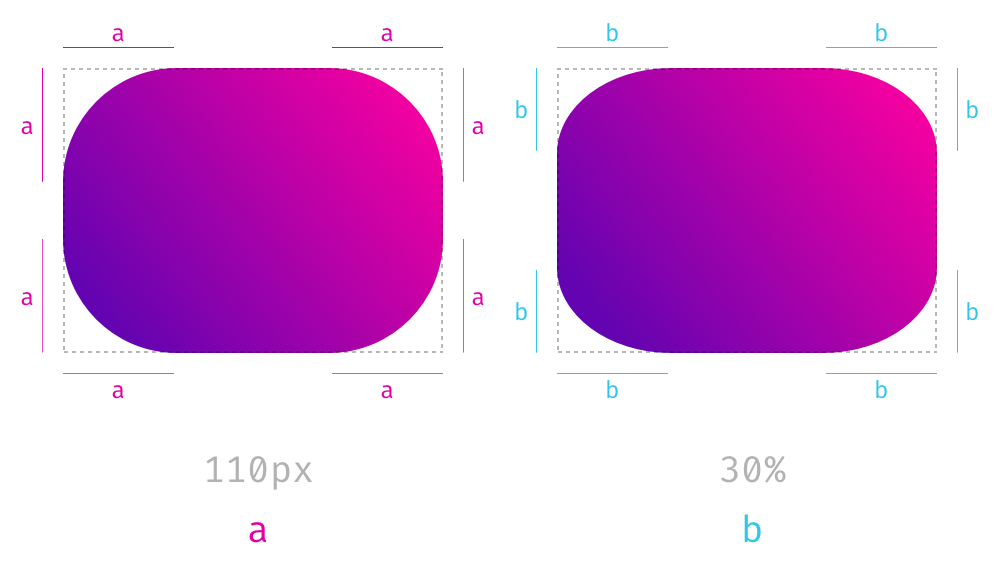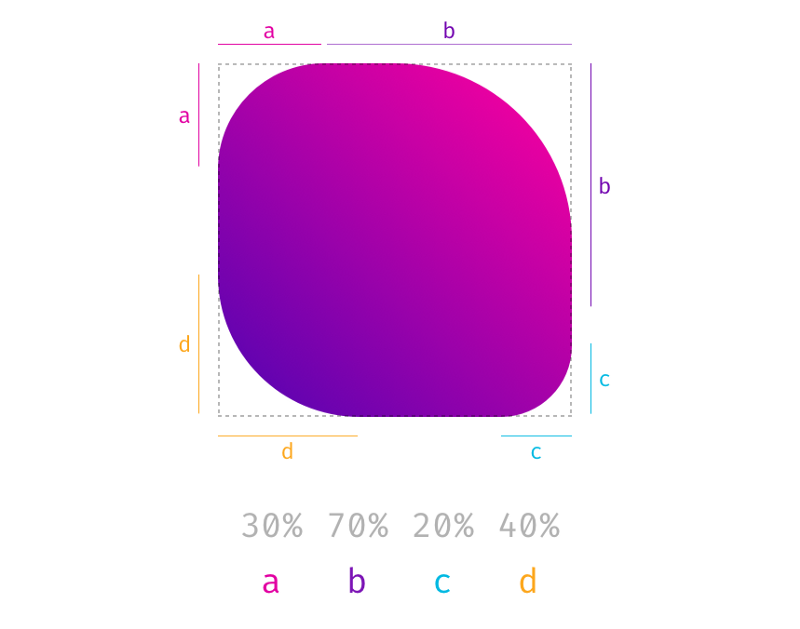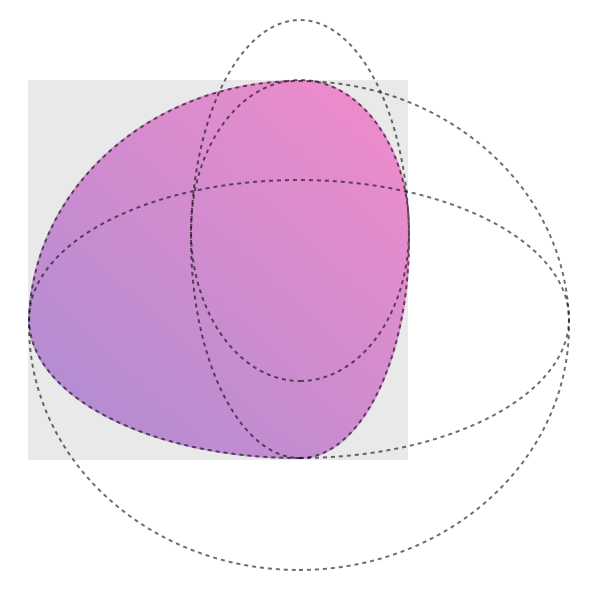CSS: interesting border-radius features
- Transfer
- Tutorial
What can be done using CSS properties

We offer to talk about the intricacies of use
This year, at Frontend Conference Zurich , Rachel Andrew gave a talk on the possibilities of CSS Grid technology. At the end of the speech, she said something about old CSS properties and her words hooked me. Namely, it sounded like this: “The image was made round exclusively using a well-maintained property
Some time after this speech, I had the idea that the circle is only a small part of what can be done with help
Let's start with the basics. I hope you are not bored by this example. You may be familiar with CSS, and with the property
When using a single value for the

Rounding of all corners of a square in accordance with a single border-radius value
As you can see from the above example, you can set fixed values not only by indicating certain units of measurement after the numbers, like

Rounding the corners of a rectangle
Note that the corners of the right rectangle are not symmetrical and remember this. We need it a little later.
When using more than one value

Setting parameters for the four corners of the element
I think many of you have already tried everything that we talked about above. Now it’s time for some really interesting experiments. What happens if the values are separated by a slash and you can specify up to eight such values? First, take a look at the specification . It tells us that if the values are set before and after the slash, then the values before the slash indicate the horizontal radius, and the values after the vertical. If there is no slash, then both radii will be the same.
So, the values before the slash are responsible for the horizontal distances, and the values after the slash are for the vertical ones. All this is good, but then the logical question arises: “What is it all about?”. Remember the percentage of rounding values given for rectangular shapes? Different absolute values were used for vertical and horizontal distances, and asymmetrically rounded corners were present. This effect can be achieved using a slash when setting up
Let's compare the effects that give the following settings:

The symmetric corners of the left element are a quarter of a circle, and the asymmetric corners of the left element are parts of an ellipse.
To be honest, the figures obtained by applying the above settings look weird. But do not forget that the circles are created using these parameters:

The shape obtained by applying 8 values separated by a slash

Four overlapping ellipses that form a shape.
It took me some time to get used to it. Sometimes all these designs can be difficult to comprehend. If you are attracted to complex forms of elements that are customizable with
Now that you know that you
- Do not cross the streams.
- Why?
- It will be bad.
The fact is that if you move the manipulators so that they intersect on one side of the figure, then it will begin to behave ... Let's just say that it will begin to behave unpredictably. What can I say - lookyourself. In the end, it will not lead to a universal catastrophe, but in doing so, remember that we warned you.
Dear readers! Do you use the border-radius CSS property?

border-radius? The author of the material, the translation of which we publish, says that more than it seems at first glance. In particular, we are talking about the fact that the angles of elements rounded with the help of this property can have a very interesting shape.
We offer to talk about the intricacies of use
border-radius.Older properties and modern web design
This year, at Frontend Conference Zurich , Rachel Andrew gave a talk on the possibilities of CSS Grid technology. At the end of the speech, she said something about old CSS properties and her words hooked me. Namely, it sounded like this: “The image was made round exclusively using a well-maintained property
border-radius. Keep in mind that old CSS still exists and can still be useful. You don't have to always use something completely new to create any effects. ” Some time after this speech, I had the idea that the circle is only a small part of what can be done with help
border-radius. Fascinated by this idea, I decided how to deal with this property.Mastering the border-radius
▍The only value
Let's start with the basics. I hope you are not bored by this example. You may be familiar with CSS, and with the property
border-radiustoo. It has existed for quite some time, and they are mainly used to indicate the only value. It looks like this: border-radius: 1em. Perhaps this was one of the most talked about features of CSS3 in 2010, when css3please.com was the designer’s best friend . When using a single value for the
border-radiuscorners of the element, they round out according to this value.
Rounding of all corners of a square in accordance with a single border-radius value
As you can see from the above example, you can set fixed values not only by indicating certain units of measurement after the numbers, like
px,remorem, but also a percent sign. This is typically used to create square-based circles whenborder-radiusset to 50%. The percentage value is based on the width and height of the element. Therefore, when it is applied to rectangles, the resulting angles will not be symmetrical. Here is an example showing the difference between propertiesborder-radius: 110pxandborder-radius: 30%applied to a rectangle.
Rounding the corners of a rectangle
Note that the corners of the right rectangle are not symmetrical and remember this. We need it a little later.
▍Four separate values
When using more than one value
border-radius, you adjust the parameters for each angle, starting at the top left and moving clockwise. Here, again, you can use percentage values. They can also be mixed with fixed values.
Setting parameters for the four corners of the element
Ос Eight values separated by a slash
I think many of you have already tried everything that we talked about above. Now it’s time for some really interesting experiments. What happens if the values are separated by a slash and you can specify up to eight such values? First, take a look at the specification . It tells us that if the values are set before and after the slash, then the values before the slash indicate the horizontal radius, and the values after the vertical. If there is no slash, then both radii will be the same.
So, the values before the slash are responsible for the horizontal distances, and the values after the slash are for the vertical ones. All this is good, but then the logical question arises: “What is it all about?”. Remember the percentage of rounding values given for rectangular shapes? Different absolute values were used for vertical and horizontal distances, and asymmetrically rounded corners were present. This effect can be achieved using a slash when setting up
border-radius. Let's compare the effects that give the following settings:
border-radius: 4em 8emand border-radius: 4em / 8em. The results are very different.
The symmetric corners of the left element are a quarter of a circle, and the asymmetric corners of the left element are parts of an ellipse.
To be honest, the figures obtained by applying the above settings look weird. But do not forget that the circles are created using these parameters:
border-radius: 50%. The circumference is obtained because the two values that specify one side are added up and it turns out 100% (50% + 50% = 100%) and there are no straight lines from the original square. If we speculate in the same vein about the eight values used in specifying the propertyborder-radius, it turns out that they can be used to describe a figure that is similar to a guitar mediator or a cell of a living organism.
The shape obtained by applying 8 values separated by a slash

Four overlapping ellipses that form a shape.
It took me some time to get used to it. Sometimes all these designs can be difficult to comprehend. If you are attracted to complex forms of elements that are customizable with
border-radius, you can use this small tool.Results
Now that you know that you
border-radiuscan use 8 values when setting up , then you, if you tried the above tool, can feel a little disappointment, as it does not allow you to control each value independently. If this is so, then here , especially for you, is its version that supports the independent adjustment of all eight values. Before you use it - remember one conversation from the movie "Ghostbusters" of 1984: - Do not cross the streams.
- Why?
- It will be bad.
The fact is that if you move the manipulators so that they intersect on one side of the figure, then it will begin to behave ... Let's just say that it will begin to behave unpredictably. What can I say - lookyourself. In the end, it will not lead to a universal catastrophe, but in doing so, remember that we warned you.
Dear readers! Do you use the border-radius CSS property?

